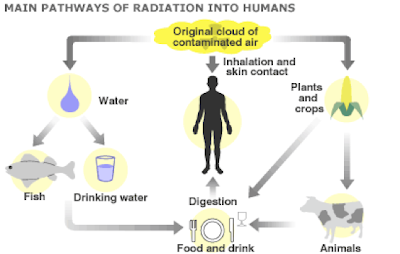Chernobyl’s
reactor number 4 exploded in the early hours of 26th April 1986, the
ensuing blaze spewed 6.7 tonnes of radioactive material from the core high into
the atmosphere, spreading radioactive isotopes over much of Europe (UN,2005). It is an event that had and continues to have a huge impact on the
development of nuclear power especially in Europe; a go to word for
anti-nuclear campaigners and an event that cannot be ignored when discussing
the pros and cons of nuclear power.
Relating it to
this blog the event serves as a useful case study with which to assess the true
impacts and risks associated with nuclear power. Here I will look mostly at the health impacts
of the event, an overview of the economic and environmental consequences of nuclear
power will be discussed later.
 |
| A runaway reaction due to mismanagement and poor design led to the overheating of reactor 4 Source:BBC,2006 |
Typical thoughts that
come to mind when thinking of Chernobyl: empty buildings, deserted playgrounds, rises in cancer rates, survivors bearing congenital deformities, and
of course the threatening concrete sarcophagus that entombs the reactor. All of
which have contributed to a sense of fear, immorality and unease; a mistrust of
all things nuclear amongst many who were affected or lived through the
event.
Yet it should be
remembered that time is the best healer and green shoots are surfacing in the
30km exclusion zone-surrounding reactor 4. I was surprised to find that today
over 3,500 workers now enter Chernobyl’s exclusion zone each day to monitor,
clean and guard the site, with a 5300 ton confinement structure the centre
piece to an impressive remediation effort (Peplow,2011).
The protective structure set to replace the temporary structure put into place shortly after the disaster at a cost of 1.54 billion euros Source:RT,2013
People are less
concerned about remediation where Chernobyl is concerned; even 27 years on much discussion
falls upon the health and environmental legacy of the event. Nuclear accidents
like Chernobyl whilst often dramatic and explosive in nature are somewhat hidden
killers with the majority of deaths coming from contamination in the years and
decades afterwards.
As a result the overall
damage is somewhat ambiguous, like many issues related to nuclear power, opinions are polarised and it is often difficult to see the wood for the
trees, estimates for the current death toll vary from under 50 (guardian,2006),
to close to a million in a study by Yablokov et al, 2010.
Firstly there are
the facts, 47 workers died from acute radiation sickness.There were in excess of 4000 cases of Thyroid cancer in highly contaminated areas, a more
than ten-fold increase from normal levels, widely accepted to be the result of
Chernobyl (UN,2005).
 Source:BBC,2006 |
Yet the further we
move away from the event both in time and space, the greater the disparities
become. A popular question often asked relates to whether Chernobyl caused a
significant rise in cancer risk across Europe and can be made responsible for
many more deaths across the continent. The problem here is that one quarter of
all deaths in Europe are the result of cancer so teasing out Chernobyl’s impact
is challenging if not impossible (Peplow, 2011).
A similar problem
is encountered when trying to find a causal link to congenital mutations which
have been so readily associated with the accident. There were many studies which suggested an increase in the rate of deformities. Yet on larger, longer term
scale a link is harder to establish. It is argued that the lack of hereditary
defects seen in children of Japan’s atomic bomb survivors would suggest that
Chernobyl is merely a scapegoat in many cases (Peplow,2011).
Complicating
matters even further, when trying to assess the magnitude of the impact on health,is the question of the inclusion of actions taken in fear following the event. In response to Chernobyl there was deemed to
be a rise in the number of abortions in countries as far a field, as Italy
and Austria (Renn, 1990). Some studies have also linked the event to an
increase in smoking, alcoholism and suicide in surrounding areas (Yablokov et
al, 2010).
‘There’s
tremendous uncertainty for these people…some think they are doomed because of radiation
exposure’ Elisabeth Cardis epidemiologist (Peplow 2011)
This uncertainty remains
because studies on Chernobyl and long-term radiation exposure have been isolated
to small regions and ill funded in recent times (Peplow, 2011). What is
needed is a coordinated European study, and I hope that in light of the more
recent Fukushima disaster in Japan, more money will be channeled into research programmes
assessing the impact of nuclear accidents. Chernobyl gives us an ideal
opportunity to study the effects of low level long term radiation exposure, and
in light of the cross roads that we have arrived at in terns of energy resources, any findings
could prove influential to future energy policy. Also better knowledge and education
could reduce the panic following nuclear accidents, which can exacerbate the
situation.
Whilst the precise health impacts are widely disputed, from research
I did get some idea of the huge psychological, and socio-economic toll nuclear
disasters can enact. Other energy sources come with there risks, dam failures,
oil spills etc but the damage they cause is not so enduring or insidious in
nature. That said I'm not ready to give up on nuclear energy yet, it should be also
remembered that climate change also threatens environmental destruction,the displacement of millions and will undoubtedly prove costly, and it would be biased to judge the
present safety of nuclear power solely on an antiquated reactor which was
poorly managed.
Thanks for reading!
References
(BBC,2006)@http://news.bbc.co.uk/1/shared/spl/hi/guides/456900/456957/html/nn4page1.
(UN, 2005)@http://www.iaea.org/newscenter/focus/chernobyl/pdfs/pr.pdf
(Guardian,2006)@http://www.theguardian.com/environment/2005/sep/06/energy.ukraine
(Peplow,2011)@http://www.nature.com/news/2011/110328/full/471562a.html
(Renn,1990)@http://elib.uni-stuttgart.de/opus/volltexte/2010/5308/pdf/ren28.pdf
(RT,2013)@http://rt.com/in-motion/chernobyl-new-shell-structure-512/
(Yablokov et al, 2010)@http://www.scribd.com/doc/61517283/Yablokov-Chernobyl-Book

Really interesting post, I had no idea that Chernobyl had such a wide range of impacts. Also, 3500 workers a day?! Sounds like quite an operation going on. You may also find this interesting, that the surrounding area is also attracting tourists! http://www.telegraph.co.uk/news/worldnews/europe/ukraine/8363569/Chernobyl-The-toxic-tourist-attraction.html
ReplyDelete